How To Set Up & Process Your Dropshipping Returns & Refunds?
I'm looking for...
Curious about the common pitfalls of dropshipping returns and how to set up an effective return policy?
This guide dives into the essential strategies to handle refunds and manage returns smoothly, ensuring customer satisfaction and keeping your reputation intact.
But are returns just an unavoidable hassle, or could they actually boost customer loyalty?
Read on to discover how the right approach to dropshipping returns can make all the difference in your business.
Create Your Online Store in just 5 Minutes – For Free
Pick your niche, our AI builds your store, add 10 winning products and we teach you how start selling today. Start picking your niche
The 5 Main Causes Of Dropshipping Returns And Refunds
Understanding what motivates your customers to return a purchase can help you build great relationships with them and minimize returns.
According to recent data, the average e-commerce return rate is around 20-30%. And, most users return their goods because of sizing issues, wrong items, purchases of multiple products with an intent to return some, or a failure to set correct customer expectations.
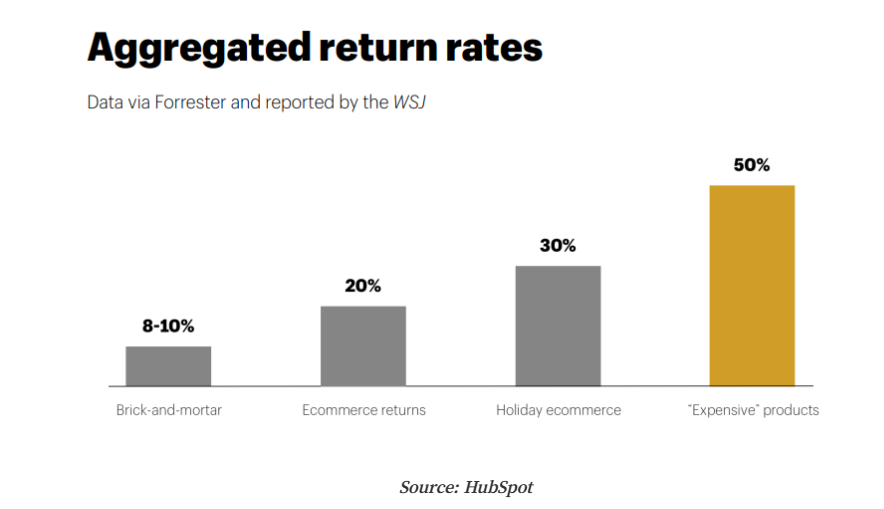
Moreover, did you know that the return cost in the US is reaching up to $400 billion annually?
Thus, this is no game, and you must acknowledge why your customers return your dropshipping products. So, let’s see the main causes.
1. Quality Issues
One of the main causes of dropshipping returns and refunds is product quality issues. When customers receive a product that is damaged, defective, or not as described, they are likely to request a return or refund. This can happen due to various reasons, such as poor packaging or mishandling during shipping.
For example, let’s say a customer orders a smartphone case from your online dropshipping store. However, when they receive the product, they find that it is cracked or does not fit their phone properly. In this case, the customer would likely request a return or refund due to the product’s quality issue.
So, since you are dropshipping, I strongly advise you to choose your suppliers carefully. They are the ones who can actually see and check the product before it is sent to the customer.
I personally search for dropshipping suppliers on the Dropshipping.com supplier directory. Here, you can get valuable insights about each supplier even before starting to work with them.
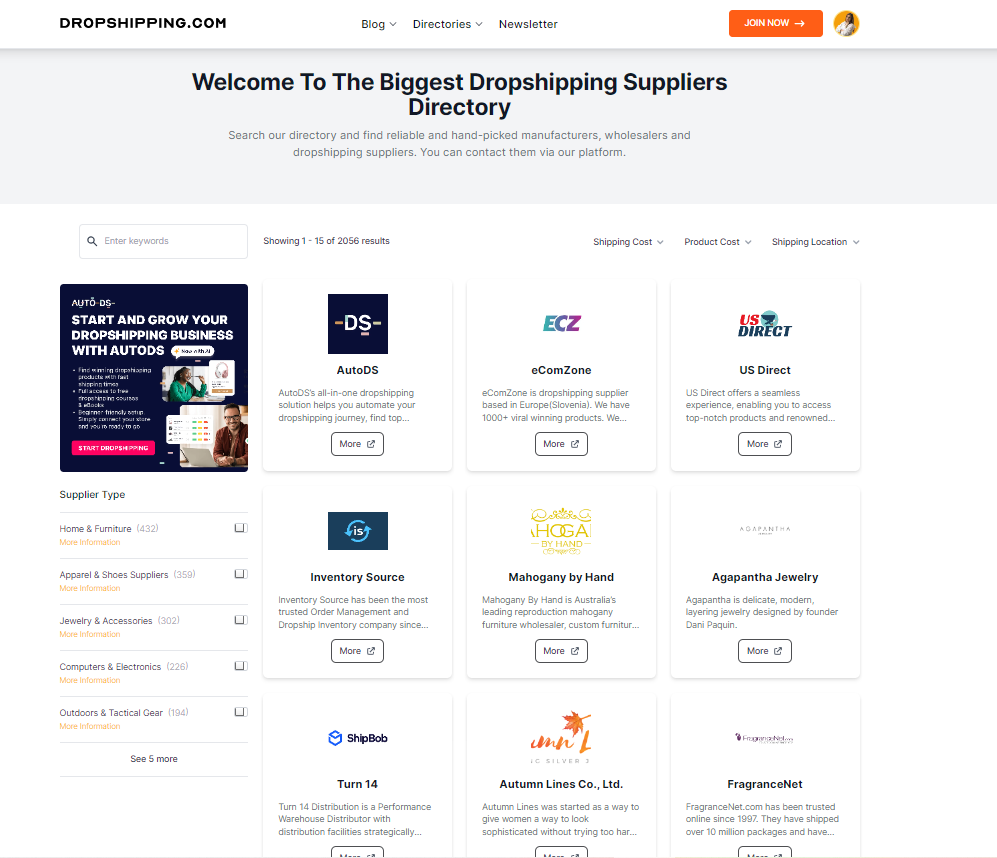
 Shipping Delays or Errors
Shipping Delays or Errors
Another cause of dropshipping returns and refunds is shipping delays or errors. When customers do not receive their orders within the expected timeframe or if their orders are lost or delivered to the wrong address, they may choose to return the product or request a refund.
For instance, once, I had an issue with a package getting lost during transit, and my customer did not receive their order within the promised delivery window. Frustrated with the delay, she decided to return the shoes and requested a refund. So, I lost my profit and a customer because of the unreliable dropshipping supplier I was working with.

2. Inaccurate Product Descriptions or Misleading Ads
Furthermore, inaccurate product descriptions or misleading advertising can also lead to dropshipping returns and refunds.
When customers receive a product that does not match the description or fails to meet their expectations based on the advertising materials, they may want to return the item or seek a refund.
For instance, this often happens with AliExpress suppliers. Hence, customers leave feedback about inaccurate product descriptions or bad product quality, referring that they didn’t receive what was promised. This affects the supplier’s rating.
Therefore, you must optimize your product pages and provide your customers with insightful product descriptions and high-quality images. Also, it is a good idea to provide a product video to showcase your product and its features.
This is one of the things I really appreciate about Quadlock. Every product page includes multiple videos that highlight the material provide usage instructions, explain the features, and more.

3. Sizing Issues or Wrong Size Ordered
Sizing is another frequent issue, especially for stores selling clothing, shoes, or jewelry. When customers can’t try items on, they often receive something that doesn’t fit the way they expected.
This happens all the time—someone orders a pair of pants or a T-shirt online, only to find the size is either too big or too small when it arrives.
With clothing, in particular, there’s a 26% return rate due to size issues. To avoid this, include a clear sizing guide in your store that matches the sizes of the countries you’re shipping to.
Also, if your products are from China, ensure you convert the sizes properly for US or European customers. This simple step can drastically reduce returns.
For instance, the ASOS marketplace offers detailed size charts on its website. They make sure to include a clear size guide for every product category. So, I decided to review the women’s dress size chart.
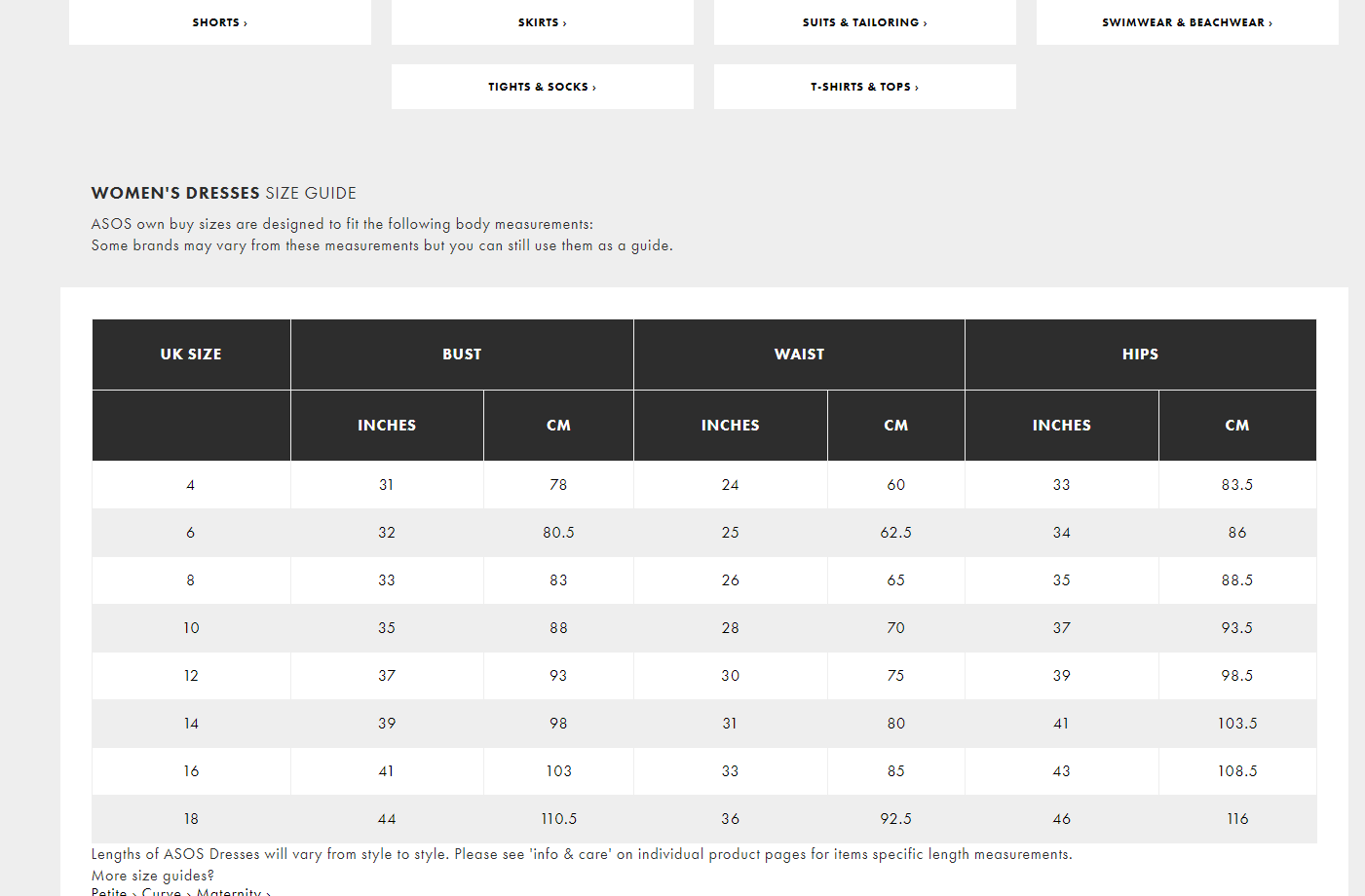
For instance, I sell necklaces, and I saw returns pile up because the sizing guide is based on Chinese measurements. Customers received items that were too tight without any explanation.
4. Damaged or Defective Products
Even with reliable suppliers, products can arrive damaged or defective, especially during transit.
Sometimes, no matter how careful you are in choosing suppliers, items might break on the way to the customer.
To handle this, always ask your customer to send photos or videos of the damaged product. This gives you proof to send to the supplier when requesting a replacement or refund.
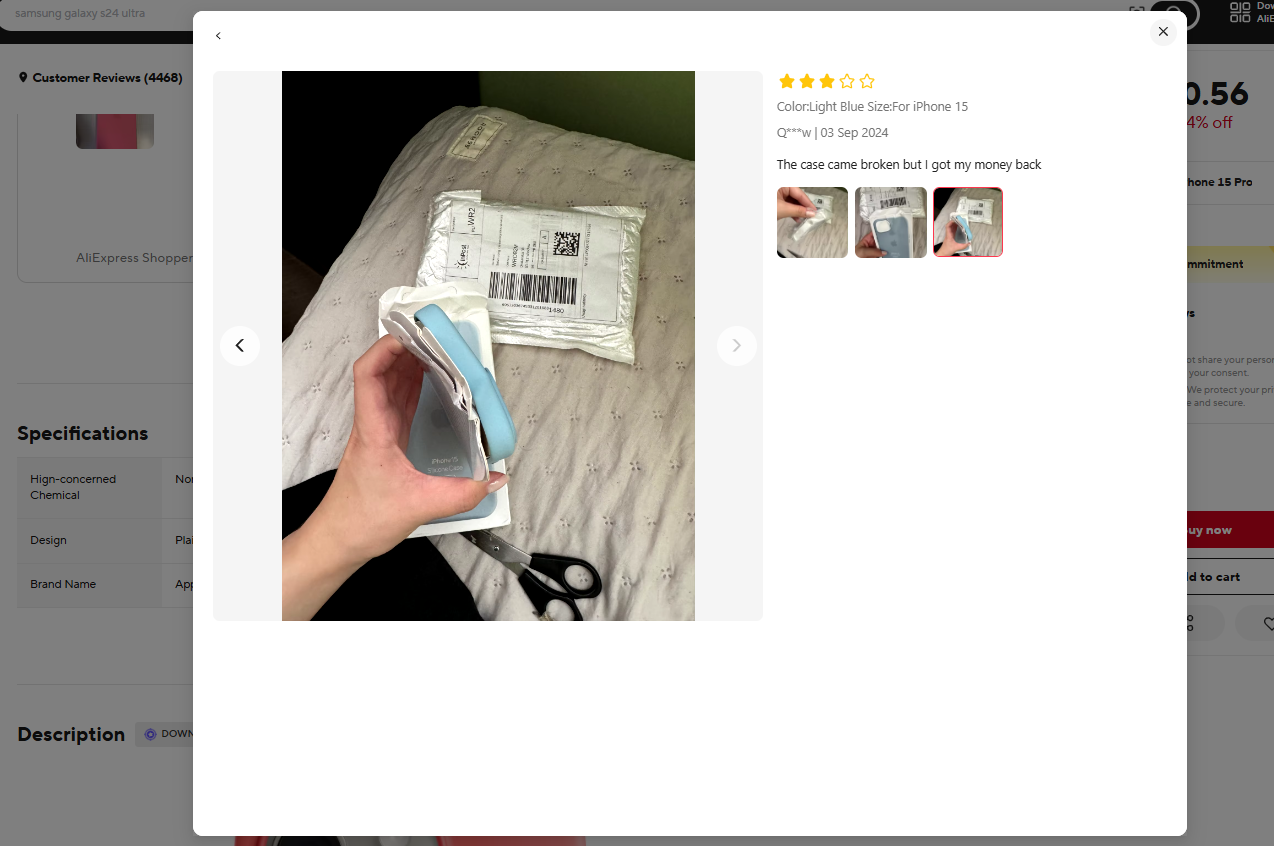
If you have a strong relationship with your supplier, they’ll often send a replacement without issue.
Meanwhile, make sure to apologize to your customers and assure them a new item is on its way. Handling these moments with care will leave a lasting positive impression.
5. Buyer’s Second Thoughts After Purchasing
Sometimes, a customer simply changes their mind after purchasing, a phenomenon known as buyer’s remorse.
They may have found a similar product at a lower price or realized they didn’t really need the item after all. While this can be harder to prevent, having a clear return policy that handles these situations smoothly can make all the difference.
Reducing buyer’s remorse starts with having accurate product descriptions and setting clear expectations. So, including customer reviews in your store can help buyers feel more confident in their decisions.
How Do Returns Work With Dropshipping?
As you are not dealing with inventory and shipping (you are a dropshipper), the concept of accepting dropshipping returns for your products may sound confusing.
Namely, your customers do not know that you are collaborating with dropshipping suppliers whenever you receive a return request. And, that is worse, because you are the main culprit even though it is not your fault. However, you have to deal with it. So, this is how it goes.
- Your customer informs you that they want to return a product.
- Then, you request a return merchandise authorization number, i.e., RMA from the supplier.
- Next, your customer sends back the product to your supplier.
- And your supplier refunds your account for the wholesale price of the product. Finally, you refund your customer for the full price of the product.
Unfortunately, some things may complicate this process. And these things include:
- Restocking fees. If your supplier charges restocking fees (extra fees for returning a product), it is not advisable to include them in your return policy. Even though you may have to cover these fees from time to time, you will probably recoup them from selling to other customers.
- Defective products. In most cases, suppliers do not cover return postage for defective products. The main reason for this is that they are not liable for defects because they are not manufacturers. But you need to compensate your buyers for the return shipping fees for defective products. After all, you want to build a successful dropshipping business, don’t you?
Learn How to Cancel a Dropshipping Order? [A Step-By-Step Guide].
Two Options for Your Dropshipping Return Process
When setting up a dropshipping return process, you’ve got two main choices: either have the returns sent back to you or let the return address be the manufacturer.
Both options have their perks, so let’s break them down, including what to watch out for with return requests, handling refunds, and keeping customers happy.
1. Returns Sent to You
If you choose to have returns sent directly to you, you get full control over inspecting the product. This gives you a chance to see if the wrong product was sent or if it arrived damaged due to the supplier’s fault.
For example, I once had a customer return a product because of wrong details in the description, and being able to see the item myself allowed me to address the issue quickly. This approach also helps you manage excess inventory by assessing the condition of items and deciding whether they can be resold.
However, you’ll need to consider the extra effort required to handle returns. You’ll be responsible for repacking the item, printing new shipping labels, and sending it back to your dropshipping supplier.
Even if your preference is to have the supplier handle the bulk of returns, it’s worth directing a few return requests to yourself to experience the return process firsthand. This way, you know exactly what your customers go through and can ensure the return instructions are clear and the return window is reasonable.
This method is especially helpful if you work with multiple suppliers. Having customers send products back to different addresses can be confusing and lead to mistakes.
2. Return Merchandise Authorization (RMA) to Your Supplier
If you don’t want to handle returns yourself, letting your dropshipping supplier manage them might be the better option. This is especially appealing if your business focuses on selling products at scale and you want to avoid the hassle of managing returns for every single order.
However, before you go this route, you need to know your supplier’s return policies. Some suppliers might charge fees or have limitations on what they’ll accept back.
Also, be sure you understand if they require you to create return merchandise authorization (RMA) forms, as this can affect how quickly you can process return requests and handle refunds. It’s critical to get these details right, so your refund policy aligns with your supplier’s fault guidelines.
You’ll also need to figure out how to cover return shipping fees. If you’re offering free returns to customers, those fees need to be built into your pricing strategy or covered by your supplier. Offering a transparent process where customers know exactly how to request a return is key to keeping them satisfied and ensuring they come back to shop again.
Even if the supplier manages the return process, your business is still the face of the transaction. Customers will contact you first for return requests, and you’ll need to ensure their ecommerce platform experience is as smooth as possible.
How To Make The Best Dropshipping Returns Policy? – 7 Best Tactics

1. Make An Easy-To-Understand Returns Process
When it comes to dropshipping, making the returns process easy and hassle-free is essential for maintaining customer satisfaction.
First things first, I suggest you automate as much of the process as possible. For instance, by using Shopify apps, you can set up a self-service return portal that allows customers to easily initiate return requests and track the progress of their returns. This not only saves time for the customer but also reduces the workload for the business owner or customer service team.
Automation also allows you to create a standardized return policy template, eliminating the need for individual negotiations with each customer. This ensures consistency and fairness in the returns process.
Additionally, providing a clear and concise return policy on the website, including information on return windows, return addresses, and applicable return shipping fees, is crucial for setting customer expectations from the start.
For example, I find the Everlast return page an easy breeze. Their return page is straightforward, clearly stating that they accept returns within a 30-day window from the date of purchase, provided that the products remain unused and in their original packaging.
The page also provides concise instructions, presented in bullets, for smooth returns and speedy exchanges, ensuring a seamless and trouble-free return and exchange experience.
2. Protect Yourself From Fraudulent Dropshipping Returns
When running a dropshipping business, it is crucial to have a fraud policy in place to protect your dropshipping business from fraudulent orders. Unfortunately, online businesses are prone to fraudulent activities, and having a robust fraud policy can significantly reduce the risks.
Therefore, you must familiarize yourself with the common signs. Thus, look out for suspiciously large orders, rush orders with expedited shipping, mismatched billing, shipping addresses high-value items being purchased with stolen credit cards.
To mitigate these risks, consider using an address verification system (AVS) to ensure that the billing and shipping addresses provided by the customer match.
If you encounter a fraudulent order, it is essential to take the necessary steps promptly. Document the original order, including all the information provided by the customer. This will be vital when reporting the fraud to the appropriate authorities or your payment processor.
Additionally, provide tracking information for the shipped order to prove that you fulfilled your part of the transaction. Be sure to respond promptly to any requests for additional information from law enforcement or your payment processor.
Here’s a great example for you. Built Athletics includes a unique fraud clause that is not commonly seen. This serves as a deterrent to discourage customers from engaging in return fraud by making them reconsider their decision.”
3. Make a FAQ Section For Your Return Policy
One important aspect of creating a seamless customer experience for your dropshipping business is having a clear and easily accessible return policy in place. To ensure that customers can quickly and easily find the information they need, it is crucial to have a Frequently Asked Questions (FAQ) section on your website.
Thus, you can include common questions and concerns related to returns, refunds, and exchanges and provide customers with valuable information upfront.
For example, you can consider answering questions such as:
- What is your return policy?
- How do customers request a return or exchange?
- What is the return window?
- How long does the refund process take?
- What are the common reasons for returns?
- What are the return shipping costs and procedures?
- How can customers reach your customer service team?
Take a look at this example. Here is a return policy template for eCommerce provided by MyProtein, which includes frequently asked questions about their return policy.
This template aids in boosting conversions by addressing customer inquiries, potentially converting users into paying customers.
4. Provide Country-Specific Return Information
Different countries have varying laws and regulations regarding returns, so it’s important to understand and comply with these to ensure a smooth return process.
When outlining your return policy, be sure to include country-specific return information. This includes providing the correct return address for each country, as well as stating any specific instructions or requirements for international returns. It’s also essential to clearly communicate the return shipping cost, as this can vary depending on the country.
By including country-specific return information in your policy, you can avoid potential complications and ensure a positive customer experience.
For instance, Gymshark excels in its return policy by effectively highlighting its region-specific return guidelines.
5. Mention Any Exceptions That May Arise
To leave no room for misunderstandings, it is crucial to outline any limitations or conditions for returns. For instance, certain products may be non-returnable due to hygiene reasons or other specific factors. Additionally, it is important to clearly state any fees associated with returns, such as return shipping costs or restocking fees.
To further clarify the return process, you should specify any additional requirements or processes. For example, this could include obtaining a Return Merchandise Authorization (RMA) number before returning a product or providing proof of purchase.
For instance, I personally got inspired by Under Armour’s return policy on this one. They mention the possibility of exceptions in their 60-day return policy. Plus, the manufacture date on the tag should be less than 2 years old.
If the customer is unable to provide proof of purchase, the return will be processed based on the most recent selling price and the refund will be issued in the form of a UA eGift card.
By clearly outlining these requirements, customers will have a better understanding of what is expected of them.
6. Have a Reliable Policy For International Dropshipping Returns
One of the main challenges with international returns is the issue of shipping costs. Unlike domestic returns, international returns often involve higher shipping costs due to longer distances and potentially multiple carriers.
Therefore, I recommend you clearly communicate and outline who is responsible for these costs – the customer or the seller.
Another complexity to consider is customs fees. Depending on the country, customers may be required to pay customs fees when returning items. Therefore, you must ensure that their return policy clearly states who will cover these fees, to avoid any confusion or dissatisfaction.
And, don’t forget about the return timeframes. Due to longer shipping times, it is important to set reasonable return windows that align with customers’ expectations. This ensures that customers have enough time to initiate a return and ship the item back.
For example, Overstock has dedicated a specific webpage for international returns, facilitating a seamless return process for customers located outside the country.
7. Understand The Dropshipping Return Policies Of Your Suppliers
Again, as you will not process the dropshipping returns yourself, you must have a good understanding of your suppliers’ return policies.
The whole return process will happen in the background. And, this involves effective communication between you and your dropshipping suppliers
But before I get any further, let me clarify one thing. You, as a dropshipper, have to write YOUR OWN return and refund policy as people will buy from your store and not directly from your suppliers.
And you have to display your return policy on your site.
Still, you must take into account your suppliers’ respective return policies before writing your own. Here is what to pay attention to in their return policies.
- How they deal with returns (the entire process);
- Whether they accept returns on wrong orders (e.g., wrong shoe size);
- Who pays the cost of return shipping;
- How long your customers can send an item back after receiving it;
- Do they charge restocking fees (and if so, what are they?)
I also want to mention that in case you work with more than one dropshipping supplier, you must know the return policy of each supplier.

How To Ensure Your Return Policy Matches With Your Suppliers?
Of course, you should not turn the return policy of your supplier into your own. Instead, you need to use their policy as a framework and make sure your policy matches theirs.
When writing your policy, please consider the following:
 Determine the timeframe during which you will accept dropshipping returns.
Determine the timeframe during which you will accept dropshipping returns.
Give your customers enough time to request a product return. For instance, if your supplier gives you a 15-day return window, you should give your customers 10-12.
 Cover the return policy of each supplier within your policy if you work with a few suppliers.
Cover the return policy of each supplier within your policy if you work with a few suppliers.
For example, one supplier may have a 30-day return period and the other a 20-day return period. If this is the case, you can give your customers a single return policy of, let’s say, 15 days for items from both suppliers.
 Avoid specifying any return address on your refund and return policy page.
Avoid specifying any return address on your refund and return policy page.
Again, if you work with multiple suppliers and specify a few addresses in your policy, it may be quite confusing for your customers. So, in your return policy, you simply need to state that your customers should contact you for more information about returns via e-mail.
 Do not accept dropshipping returns that do not have a tracking number.
Do not accept dropshipping returns that do not have a tracking number.
You do not want your customers to claim they sent the product back to you, and it gets “lost” in the mail, right?
How To Create A Return Policy Page For Your Dropshipping Store On Shopify?
If you are about to use Shopify for dropshipping, you need to know how to create your Shopify return policy page to be clear about your dropshipping returns.
Want to set up your first store on Shopify but do not how to create your Shopify return policy page? Then read on!
To create your Shopify return policy page, you need to follow these steps
Step 1 – Log in and go to your Shopify admin page. 
Step 2 – Open The Pages Section
Then, you need to open up the “Online Store” tab and select “Pages”. And, the next thing you need to do is click the “Add Page” button.
Step 3 – Create a title for your return policy page.
For instance, you can use something like, “Refunds and Returns Policy”. Also, from here, you can boost it for SEO, customize the page layout, etc.
Step 5 – Create your Dropshipping Return Policy
Go to the “Content” box and include clear information regarding your dropshipping returns. Cover several points to ensure that your customers know the limits and restrictions your store places on returns.
For example, I find Shopify’s refund and return policy generator very useful. Plus, it is all for free. Hence, it helps me generate a refund and return policy.
At the bottom of the page, click “Save”.
Step 6 – Add Your Dropshipping Return Policy To Your Navigation page
Finally, click on “add it to your store’s navigation” to ensure that people who visit your site can actually see your Shopify return policy page.
First, you can access this section by clicking on the “add it to your store’s navigation” from the “Pages” section.
Or, you can simply go through Online Store> Navigation. Either way, click on “Add Menu”, and add your Returns & Refunds page there.
How To Handle Dropshipping Returns In An Expert Manner?
I know that handling dropshipping returns may be one of the thorniest problems for you. But, you must learn how to become a problem solver.
Think of the restaurant service. What would a waiter do if there’s an order return? Of course, the waiter almost always accepts a dish sent back and fires a new order for their guest as soon as possible. There’s no difference in the dropshipping world as well. You also need to accept and deal with dropshipping returns the right way.
Also, as online shopping has become the preferred method for a lot of people, the importance of providing simple, quick return solutions is crucial.
So, here is how I handle dropshipping returns professionally:
1. Determine The Reason Why Your Customer Wants A Return
When a buyer submits a return request, the first thing you need to do is ask them why they want to return the item. Just ensure your tone is apologetic and positive rather than negative and suspicious.
Another important thing you need to do as a dropshipping store owner is to ensure the product meets all the requirements so that you can process the return.
And remember that, it is one thing to accept a return if the product is damaged/wrong, or if it does not match the product description. But, it’s quite different to accept a return if the customer has already used the item or simply changed their mind.
2. Apologize To Them For The Issue
I know, most of the time is not even your fault. Your supplier is responsible for solving problems with dropshipping returns. But, your customer does not know that. So, you are the face that needs to apologize and respond to customer complaints.
That’s why you should never blame your supplier for the mistake, no matter if they sent the wrong or damaged item, etc.
So, you can write something like this to your customer in order to apologize for the inconvenience:
“Dear [the name of your customer],
Please accept our sincerest apologies for the delivery of [e.g., wrong order] to your address. We are really sorry that …”
3. Respond To The Dropshipping Returns Request
Once you have apologized to your customer, it is time to respond to the return request. That’s to say, you need to let your customer know that you are going to fix the problem.
It is important to check if it is cheaper for you to ask your customer to return the item to your supplier or to simply send a new item to them without asking them to return the first one. In some cases, return shipping can be more expensive than sending a replacement to your customer.
Also, before mentioning a refund, check if your customer is able to wait for a replacement or not
Either way, you must contact your dropshipping supplier before verifying your customer’s replacement/return request.
4. Contact Your Supplier
Whether your customer wants a replacement or their money back, you must inform your dropshipping supplier about the issue. As mentioned above, you need to request an RMA number from the supplier.
If your supplier approves the return, you need to give your customer the return address and the RMA number. Keep in contact with your supplier to stay informed about the entire return process.
Depending on your customer’s preferences, your supplier will either ship a new product to them or refund your account for the wholesale price of the product. If your customer wants a refund, then you need to refund them for the full price of the product.
How To Handle Dropshipping Returns When Working With AliExpress Or Chinese Suppliers?
Dealing with dropshipping returns when sourcing from AliExpress or Chinese suppliers may not be that simple.
The main reason for this is that you might not want your customer to send the item back to China, particularly if your customer is not based in China.
Also, when there is a problem with an order a customer places on your site, it is often because the order never arrived (a missing item) or your customer is unhappy with the product.
This means that AliExpress dropshipping returns often happen due to the long shipping times or the goods do not match the description.

Case No.1 – Order Never Arrived (a Missing Item)
For the first case, you must discuss the problem with your AliExpress supplier and ask them to resolve the issue. So, in this case, you can probably open a dispute on AliExpress, and the supplier will return the money.
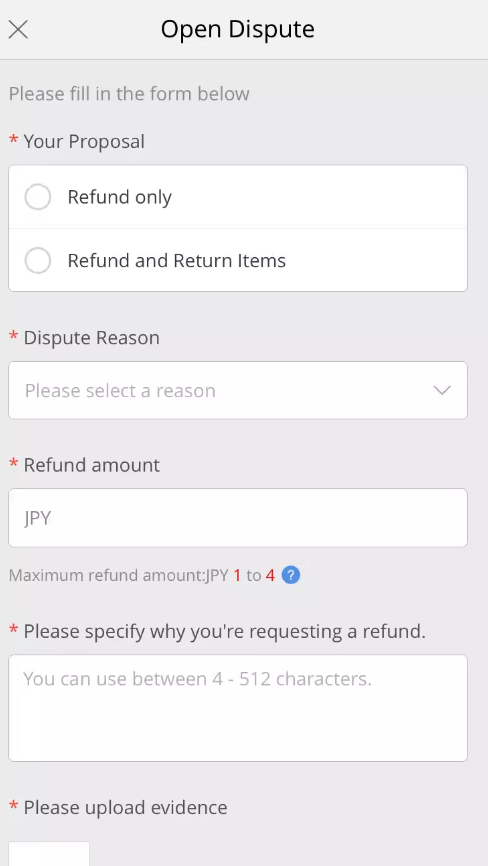
Case No.2 – The Customer Is Unhappy With The [roduct
However, for the second case, using better-quality product photos and being as specific and realistic as possible in your product descriptions would be wise.
For example, what I do when dealing with Chinese suppliers, is I order products from them as a customer. This way, I can check on the product’s quality, the shipping times, etc.
Also, on AliExpress, I use the Up Assistant extension, so I can check on the seller’s rating and credibility.
Nevertheless, once you and your supplier have made the mistake, you must take responsibility and do your best to make things right. Contact your supplier and resolve the issue together.
Also, when it comes to creating your AliExpress return policy, you must write a crystal clear return policy so that your customers know what to expect from you.
That way, you will not only minimize the rate of dropshipping returns, but you will also make your customers happy.
How To Get Fewer Refunds And Dropshipping Returns Requests?
While it’s impossible to avoid returns altogether, there are steps you can take to minimize the number of refunds and return requests you receive.
 Choose Your Dropshipping Suppliers Wisely
Choose Your Dropshipping Suppliers Wisely
As I already mentioned, in dropshipping, suppliers are the ones that send your orders to your customers. And, of course, you must be sure that the products to be sent are high-quality products. Plus, you need to be sure about the shipping times’ accuracy.
So, what you can do to ensure this?
- Ask for product samples. By requesting product samples from your customers, you can check on the product’s quality.
- Consider the location of the suppliers. Opt for suppliers who are closer to your target market, as this can significantly reduce shipping costs and delivery times. Faster shipping and delivery enhance the overall customer experience and increase customer satisfaction.
- Supplier reviews also play a vital role in the selection process. Regularly check and evaluate the feedback left by other dropshippers or businesses who have worked with the suppliers you’re considering. Look for positive reviews that highlight reliable shipping, product quality, and exceptional customer service. This will give you valuable insights into the supplier’s reliability and trustworthiness.
For example, I always search for reliable dropshipping suppliers from the Dropshipping.com supplier directory, They have a huge supplier base of 2000+ suppliers from various dropshipping niches.
 Write a Reliable Product Description
Write a Reliable Product Description
Well-written product descriptions provide accurate specifications, detailed features, and clear instructions, ensuring that your customers know exactly what they are buying.
By accurately conveying the product’s size, material, color, and other essential details, customers’ chances of receiving something different from their expectations diminish significantly.
Including key elements in the product description can further prevent returns. Customers can ascertain if the item will fit their needs by mentioning specific measurements.
Moreover, the power of descriptive and emotional language should not be underestimated. Using enticing adjectives, storytelling, and evoking emotions can create a compelling narrative that captures the customers’ attention and makes them want to possess the product. For example, this is a great technique if you are selling vintage products.
So, if you have no idea how to do it, you can try using ChatGPT as a help. So, give instructions and your requirements, and the app will provide you with a great product description.
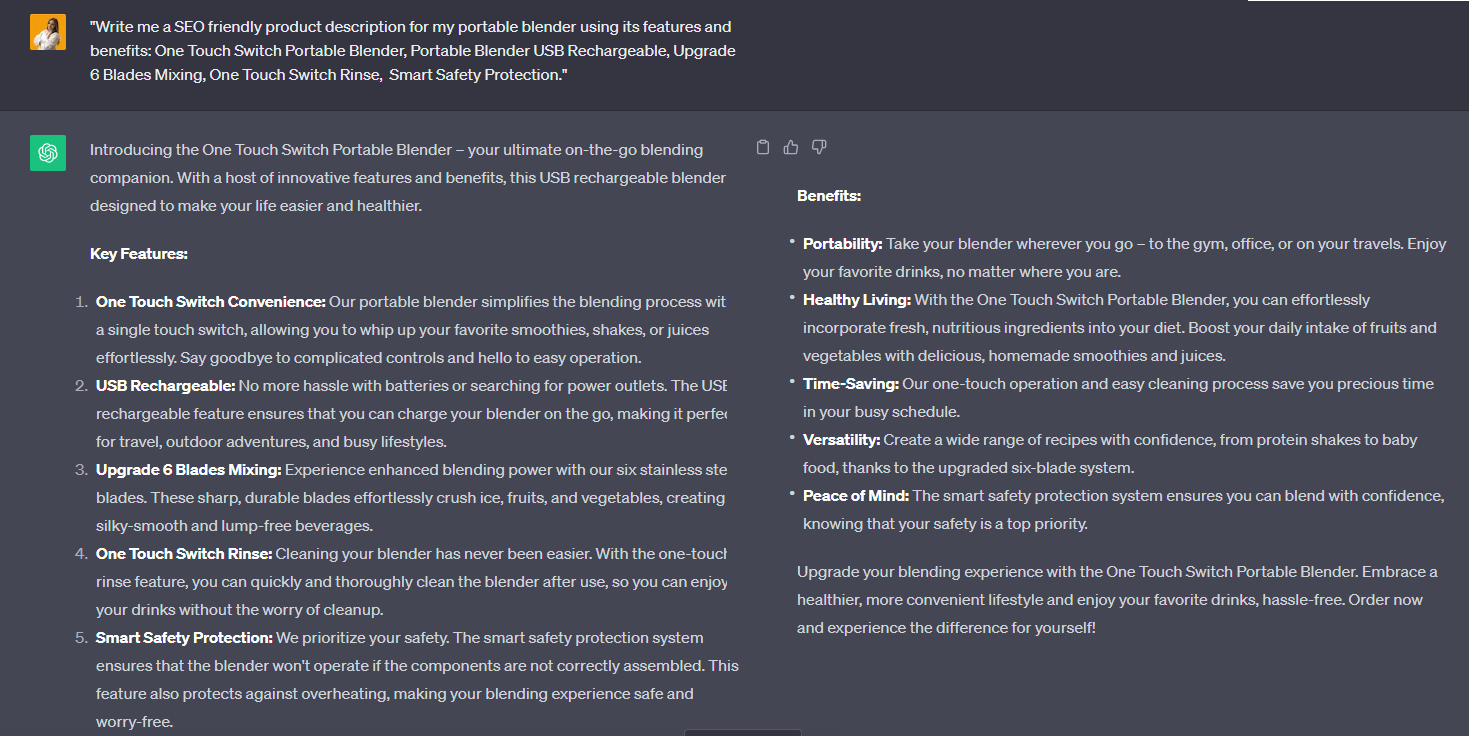
For instance, I always find Quadlock’s product descriptions inspiring. They thoroughly cover every aspect, from product details and features to material and size information.
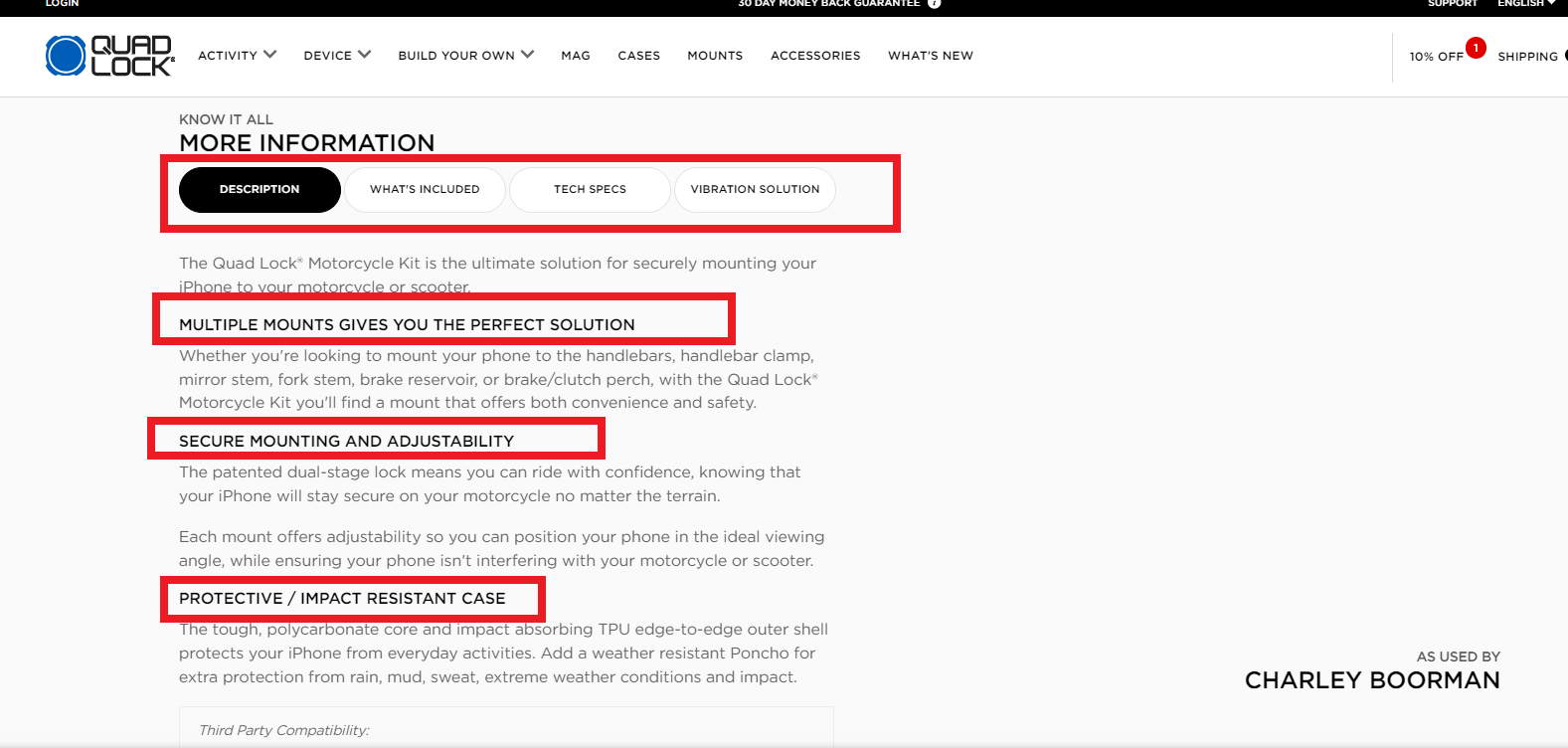
 Use High-Quality Product Photos
Use High-Quality Product Photos
High-quality product photos play a crucial role in attracting customers and convincing them to make a purchase.
A good product photo should accurately depict the item’s condition, colors, and fit. It should provide customers with a clear and realistic idea of what they can expect to receive.
To achieve this, it is important to use high-resolution, real-life product images. Furthermore, using actual person models to showcase your products is highly recommended. This gives customers a better sense of the product’s size and appearance when worn or used in real life.
For instance, Gymshark is an excellent example of how a product page should look. They showcase their products in actual models and offer multiple high-resolution and quality photos. This way, customers can clearly see every angle of the product.
 Decrease Delivery Times
Decrease Delivery Times
If you want to decrease your delivery times, I recommend you consider working with dropshipping suppliers that have warehouses located closer to your customers. This can significantly reduce shipping time, as products can be shipped directly from nearby warehouses.
Alternatively, you may opt to work with a dropshipping agent who has a worldwide fulfillment center. This central hub allows for faster shipping to customers worldwide.

In any case, it’s important to manage customer expectations by informing them about potential delays in delivery. Transparency is key to reducing the likelihood of return requests.
Also, no matter what, always be sincere about the shipping times. This is the best way to avoid dropshipping refunds and returns. So, you can place a section on your product page, giving the shipping info to customers.
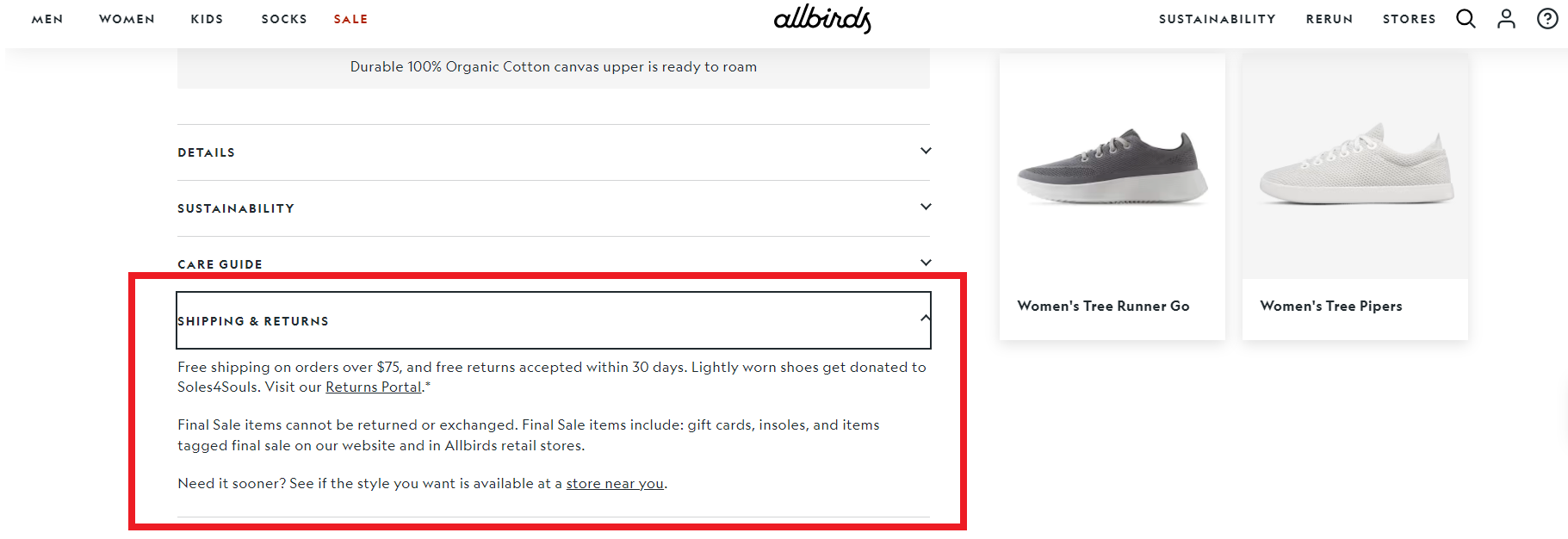
 Stay In Touch After The Purchase
Stay In Touch After The Purchase
This is equally important as being in touch before or during the purchase. So, you can consider sending a post-purchase confirmation email to your customers. This email should include order details, tracking information, contact information, and expectations.
By providing this information, you are not only reassuring the customer that their order is being processed but also providing them with all the necessary information they may need in case they have any questions or concerns.
Additionally, offering returnless refunds for expensive-to-return items can be a great way to improve the overall customer experience.
Why Does Dropshipping Businesses Need a Return Policy?
 Boost Customer Satisfaction with a Clear Return Policy
Boost Customer Satisfaction with a Clear Return Policy
Having a solid return policy has saved me so many times! When I set up my dropshipping business, I made sure to offer a 30-day return window where customers can easily request a return if something doesn’t fit or meets their expectations.
For example, a customer ordered a jacket that was too snug, and thanks to the clear return process, they returned it with no hassle.
They ended up shopping with me again because they trusted how I handled the refund request, which is exactly what you want for customer satisfaction and loyalty in a dropshipping store.
 Simplify Returns with Multiple Suppliers
Simplify Returns with Multiple Suppliers
Since I work with several dropshipping suppliers, things can get messy if returns aren’t organized.
That’s why I’ve put a lot of effort into making sure my return process clearly states where customers need to send items back, depending on the supplier.
Once, a customer accidentally sent a watch to the wrong return address, but because my return instructions were so clear, we quickly redirected it to the right supplier, avoiding shipping delays and confusion. It saved time and kept the customer happy.
This is especially important in a dropshipping business model with multiple return requests from different suppliers.
 Reduce Disputes with Transparent Return Shipping Fees
Reduce Disputes with Transparent Return Shipping Fees
I’ve learned that being upfront about return shipping fees is crucial. In my store, smaller items like jewelry have free returns, but larger products, like electronics, require the customer to cover the return shipping costs.
Once, a customer returned a phone charger, and since they knew beforehand that the return was free, the refund process went smoothly. By clearly stating who handles the return costs, I avoid confusion, protect my profit margins, and keep the focus on customer satisfaction.
 Build Trust with Clear Return Instructions
Build Trust with Clear Return Instructions
I always provide step-by-step return instructions so that customers know exactly how to handle a return. When a customer needs to return an item, such as a blender, I make sure they have the return merchandise authorization (RMA), the return shipping label, and clear directions on where to send the item.
Clear instructions like these make sure the returns process is seamless and reduce any stress for the customer. This level of transparency is key to running a successful ecommerce store and meeting customer expectations.
 Strengthen Customer Loyalty with Excellent Return Processes
Strengthen Customer Loyalty with Excellent Return Processes
In my online business, I’ve found that offering free returns for first-time purchases helps build strong customer loyalty. Recently, a new customer returned a pair of shoes they didn’t like, and since the return process was quick and easy, they not only left a glowing review but also returned to buy more.
This kind of positive experience, with no stress over return shipping costs or delays, is what keeps customers happy and loyal to my dropshipping store.
It also ensures my ecommerce business thrives, as customer loyalty is built on these smooth interactions.
Top 3 Shopify Apps For Creating Dropshipping Returns
1. ExchangeIt Returns & Exchange
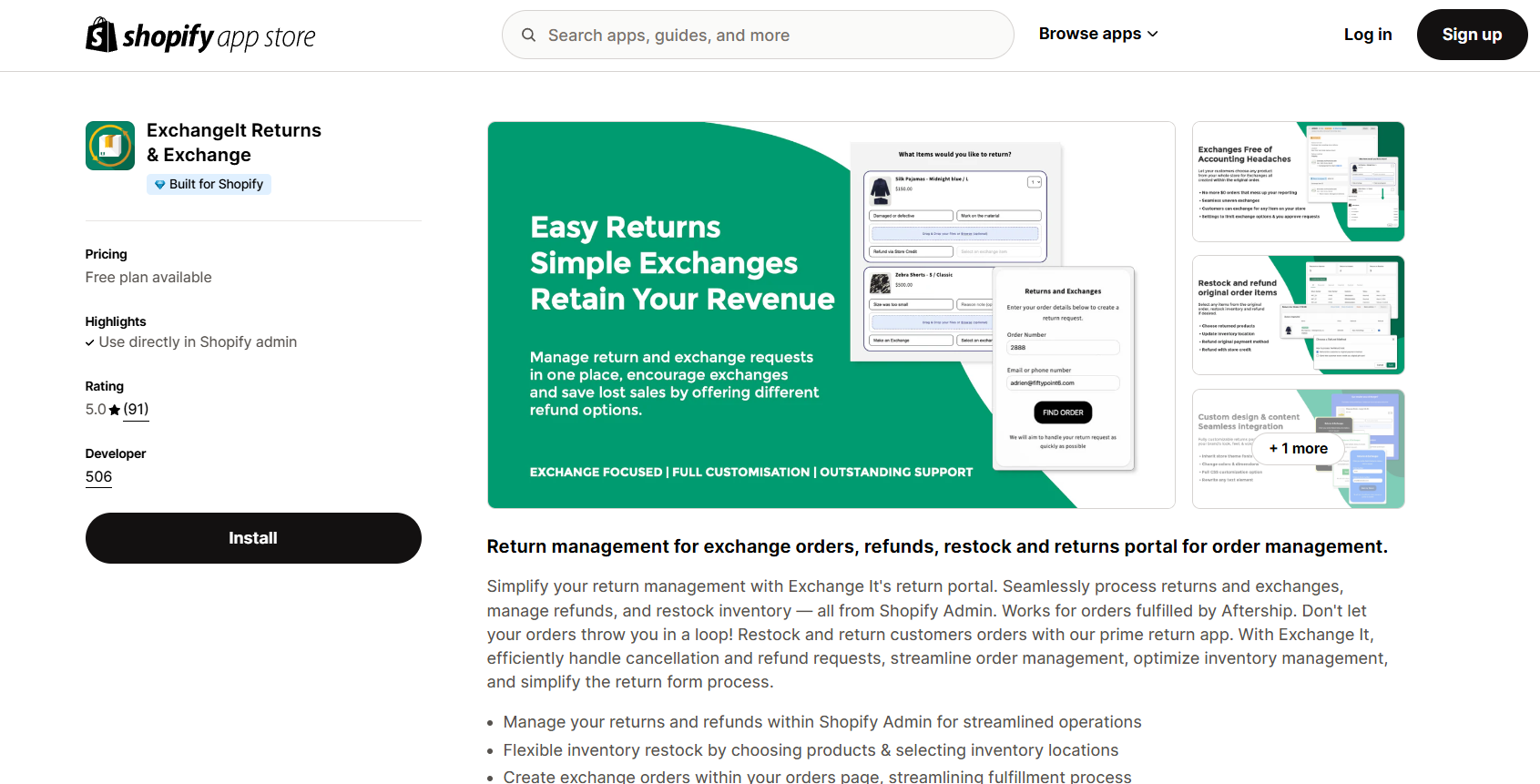
ExchangeIt Returns & Exchange is designed for efficient return and exchange management directly within Shopify Admin.
The app allows you to restock, refund original order items, and create exchange orders directly from your orders page.
It simplifies the return process by offering a custom-branded return portal and automating refunds and exchanges. With flexible refund options and support for custom return policies, ExchangeIt integrates seamlessly with AfterShip.
The app has a free plan for up to 10 returns, with paid plans starting at $9.99 per month for unlimited returns.
2. ReturnGO Returns & Exchanges

ReturnGO automates returns and exchanges through its branded self-service return portal. The app lets you set custom return rules, offer store credits, and integrate with multiple carriers for return labels.
Powered by AI, ReturnGO automates return approvals and refunds, while also providing detailed analytics to help you optimize your process. Plans start at $23 per month with a 14-day free trial to explore all the features.
3. AfterShip Returns & Exchanges
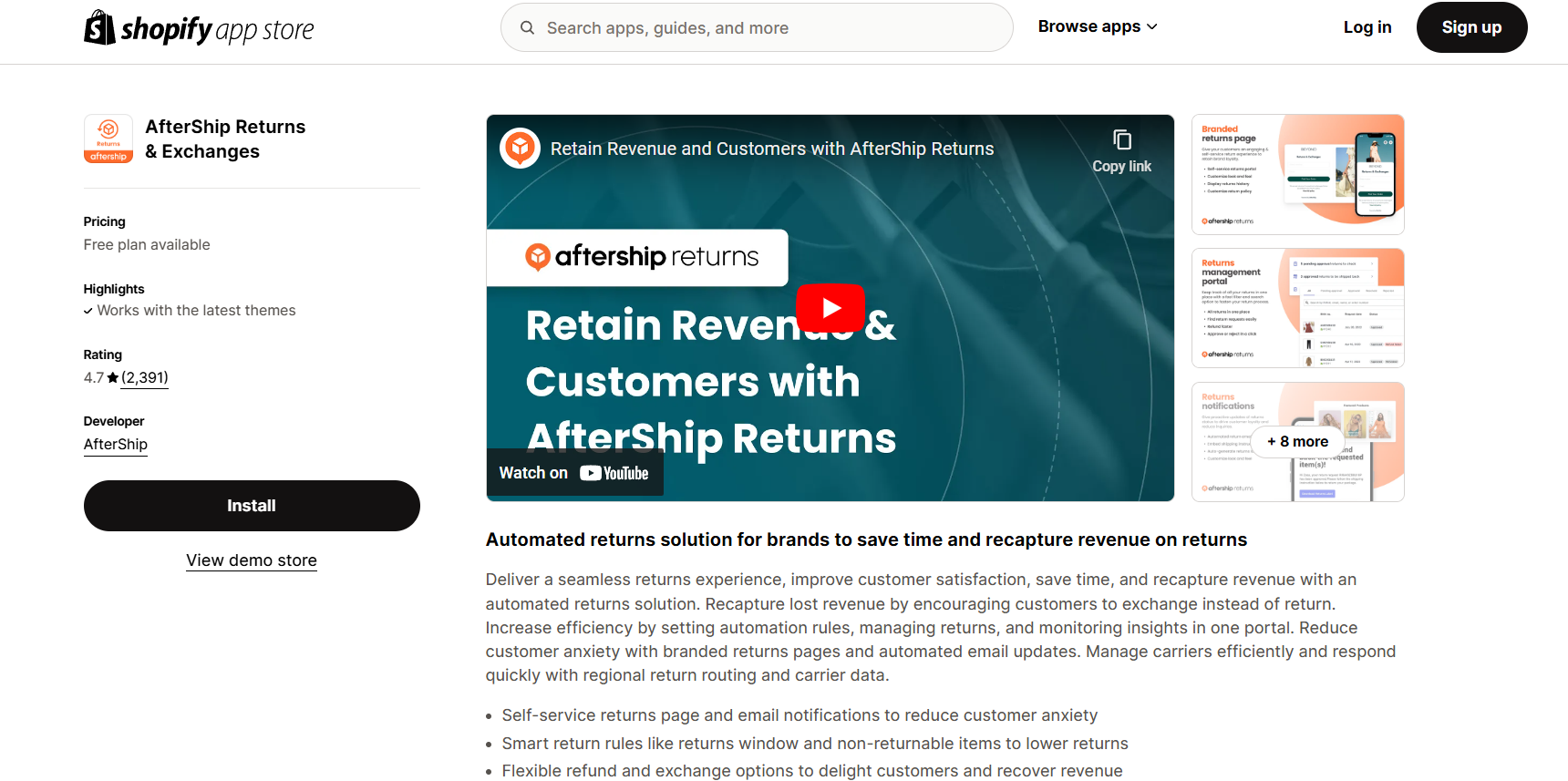
AfterShip Returns & Exchanges offers a branded, self-service return portal that automates the returns process and helps recapture revenue by encouraging exchanges instead of returns.
The app allows you to set smart return rules, automate refunds, and manage carrier settings for efficient package returns.
It integrates with multiple carriers like UPS, FedEx, USPS, and supports multi-language functionality. AfterShip’s free plan includes up to three returns per month, with paid plans starting at $23 per month.
Conclusion
Setting up a clear, reliable dropshipping returns policy is essential for managing customer expectations and minimizing disputes.
In my opinion, a well-crafted policy is not just a requirement; it’s a powerful tool for building trust and loyalty.
Remember, quality issues, shipping delays, and inaccurate product descriptions are among the top reasons for returns, so be meticulous with your supplier choices and product listings.
Always consider the extra steps needed to handle international returns, define who covers shipping fees, and make sure your policy aligns with each supplier.
Before starting, think through these key factors—doing so can save time, build credibility, and ultimately boost your dropshipping success.















![The Top 21 3PL Companies Compared [2025 List & Guide]](https://images.weserv.nl/?url=https://prod-dropshipping-s3.s3.fr-par.scw.cloud/2024/03/Frame-3922469.jpg&w=420&q=90&output=webp)